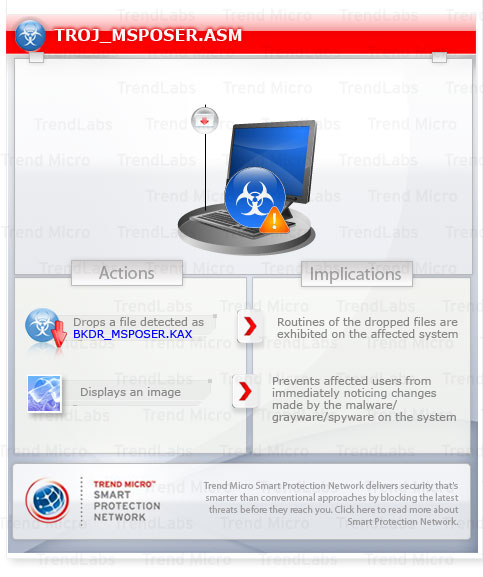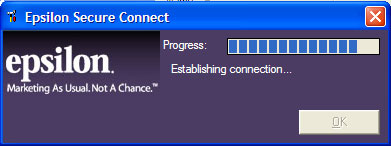TROJ_MSPOSER.ASM
Windows 2000, Windows XP, Windows Server 2003


Threat Type: Trojan
Destructiveness: No
Encrypted: Yes
In the wild: Yes
OVERVIEW
This Trojan has received attention from independent media sources and/or other security firms. In particular, it takes advantage of the Epsilon data-breach incident that was reported in the media.
To get a one-glance comprehensive view of the behavior of this Trojan, refer to the Threat Diagram shown below.

It drops specific files on the infected systems, which are detected as BKDR_MSPOSER.KAX. As a result, routines of the dropped backdoor are exhibited on the system.
It also displays an image, to avoid being immediately noticed by user.
This Trojan may be unknowingly downloaded by a user while visiting malicious websites.
It executes the dropped file(s). As a result, malicious routines of the dropped files are exhibited on the affected system.
TECHNICAL DETAILS
Arrival Details
This Trojan may be unknowingly downloaded by a user while visiting malicious websites.
Installation
This Trojan drops the following files:
- %Application Data%\IExplore.exe - detected as BKDR_MSPOSER.KAX
- %User Profile%\My Documents\SearchIndex\searchindex.exe - detected as BKDR_MSPOSER.KAX
(Note: %Application Data% is the current user's Application Data folder, which is usually C:\Windows\Profiles\{user name}\Application Data on Windows 98 and ME, C:\WINNT\Profiles\{user name}\Application Data on Windows NT, and C:\Documents and Settings\{user name}\Local Settings\Application Data on Windows 2000, XP, and Server 2003.. %User Profile% is the current user's profile folder, which is usually C:\Windows\Profiles\{user name} on Windows 98 and ME, C:\WINNT\Profiles\{user name} on Windows NT, and C:\Documents and Settings\{user name} on Windows 2000, XP, and Server 2003.)
It drops the following copies of itself into the affected system:
- %Application Data%\pl.exe
(Note: %Application Data% is the current user's Application Data folder, which is usually C:\Windows\Profiles\{user name}\Application Data on Windows 98 and ME, C:\WINNT\Profiles\{user name}\Application Data on Windows NT, and C:\Documents and Settings\{user name}\Local Settings\Application Data on Windows 2000, XP, and Server 2003.)
It creates the following folders:
- %User Profile%\My Documents\SearchIndex
(Note: %User Profile% is the current user's profile folder, which is usually C:\Windows\Profiles\{user name} on Windows 98 and ME, C:\WINNT\Profiles\{user name} on Windows NT, and C:\Documents and Settings\{user name} on Windows 2000, XP, and Server 2003.)
Dropping Routine
This Trojan executes the dropped file(s). As a result, malicious routines of the dropped files are exhibited on the affected system.
Other Details
This Trojan displays the following images:
SOLUTION
Step 1
For Windows XP and Windows Server 2003 users, before doing any scans, please make sure you disable System Restore to allow full scanning of your computer.
Step 3
Identify and terminate files detected as TROJ_MSPOSER.ASM
- If the detected file is displayed in either Windows Task Manager or Process Explorer but you cannot delete it, restart your computer in safe mode. To do this, refer to this link for the complete steps.
- If the detected file is not displayed in either Windows Task Manager or Process Explorer, continue doing the next steps.
Step 4
Search and delete this folder
- %User Profile%\My Documents\SearchIndex
Step 5
Scan your computer with your Trend Micro product to delete files detected as TROJ_MSPOSER.ASM. If the detected files have already been cleaned, deleted, or quarantined by your Trend Micro product, no further step is required. You may opt to simply delete the quarantined files. Please check this Knowledge Base page for more information.
Did this description help? Tell us how we did.


